|
Baking fish goes back to the beginning of history. Not only is it simple, but baking takes advantage of almost the entire fish as a food resource. Shown here is a Talapia which was purchased at a local Superstore food section. It is already gutted and ready to bake. |
|
Fish tastes great by it’s self but I like to add seasonings in the abdominal cavity and on the outside surface. |
|
The fish is wrapped in foliage or wet paper. I find that cabbage leaves work well and is easily obtained at the local grocery store. It keeps the fish moist and acts as a barrier between the food and clay. |
|
I place a mixing bowl inside a plastic grocery bag to protect the bowl as well as enabling my hand to slip between the bag and bowl surface in order to help form the clay wrap which should be 1/2″ – 1″ thick. |
|
Complete the clay outer layer and you’ll end up with a football shaped mud ball. Seal any open holes or seams. |
|
Place the fish mud ball on top of the coals and then place coals on top. For those who do dutch oven cooking this will be a familiar process using charcoal briquettes. I have found that using charcoal briquettes works better for this procedure because air can flow between the briquettes thus keeping them alive, whereas wood coals can be packed and tend to snuff out, requiring refreshed coals and/or a longer cooking time. Charcoal briquettes require about a 45 minute cook time whereas wood coals may take 60-75 minutes. |
|
When the estimated cook time is finished, uncover the clay ball and examine it for hardness. A hard surface indicates that it’s finished whereas a soft surface indicates a need for further cooking. Like any cooking, if you feel that it’s not quite done, just let it bake some more. A hatchet is a handy opening device but a sharp rock will accomplish the same task. |
|
When the surface is broken open, steam will come drifting out and by further opening the encasing, you will reveal an aromatic and visual delight. Transparent meat becomes opaque when it’s fully cooked. Use a fork to test the outer skin and meat for easy flaking and separation. You’ll find that the meat will virtually fall off the bones and makes access to all the tasty meat easy.  |
3 thoughts on “How To Bake Fish In Clay”
Leave a Reply

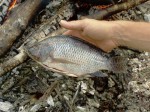
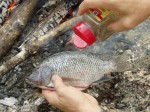
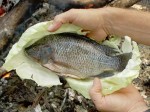
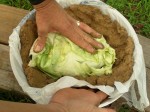
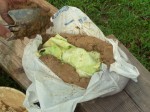
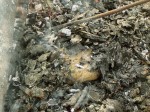
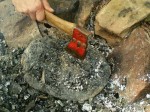
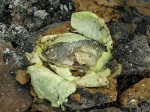


Man…that sounds delicious. Got to try that… Amazing site as well!
As a young man, I camped w/a family below Sandstone Falls that used a method handed down from Native American Indians: a gutted fish w/scales was wrapped in large green leaves growing along the New River, then encased in clay and baked in glowing campfire coals. When hardened, the lump was cracked open w/a hatchet. The scales and skin remained with the leaves, leaving the white flesh easily removed from the bone. Cannot remember what kind of leaves were used, but the results were delicious!
I remember catching edible fish, clams of 8 inchs in the river south of where I now live. Now however the chemicals the farmers use have killed all the wild foods I used to collect. The river is now full of mud from the drainage tiles and where I caught edible fish before it is now dry dirt.